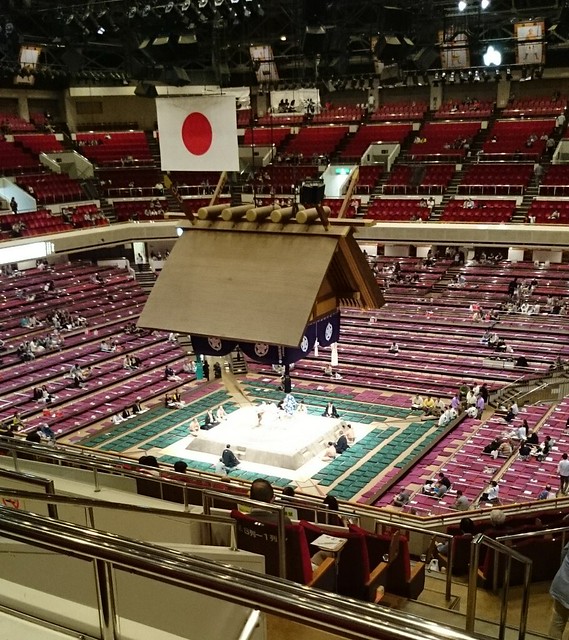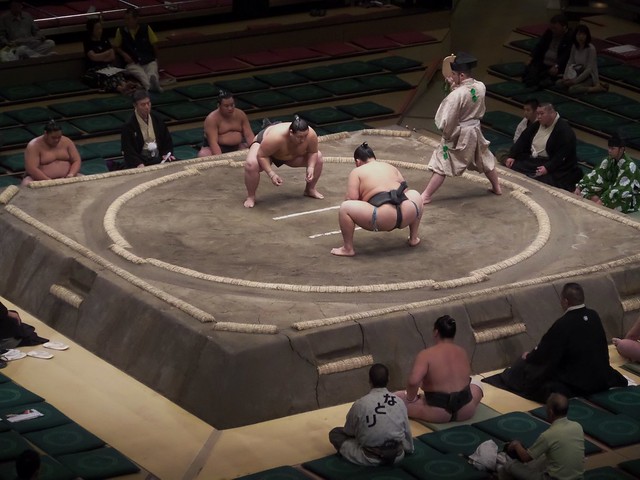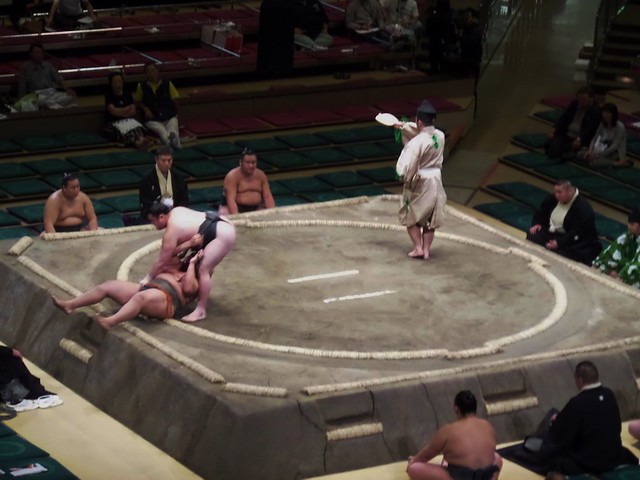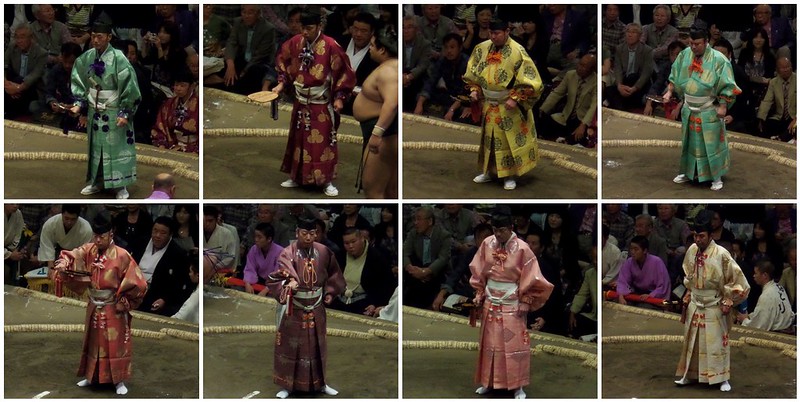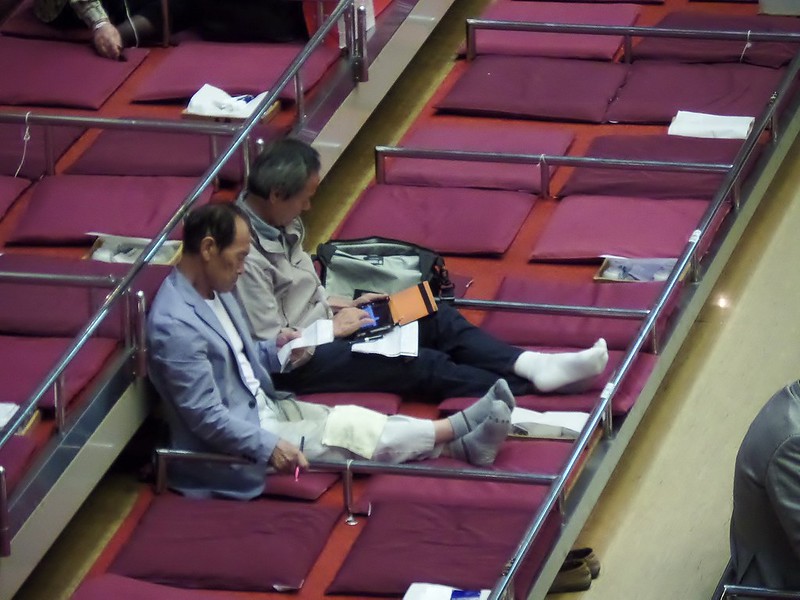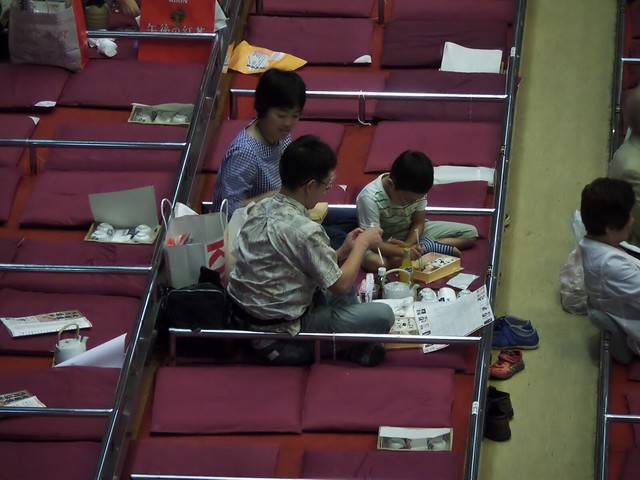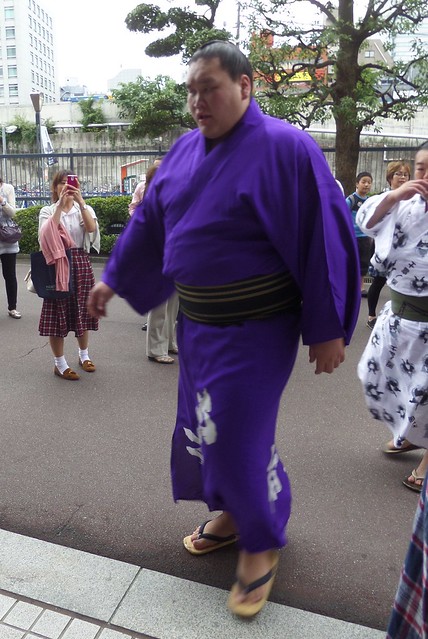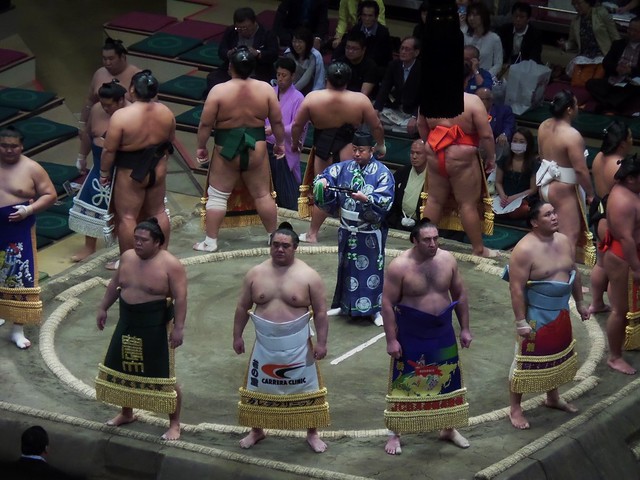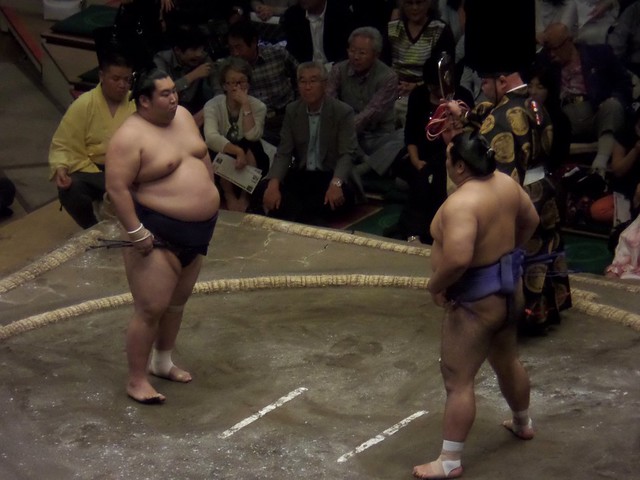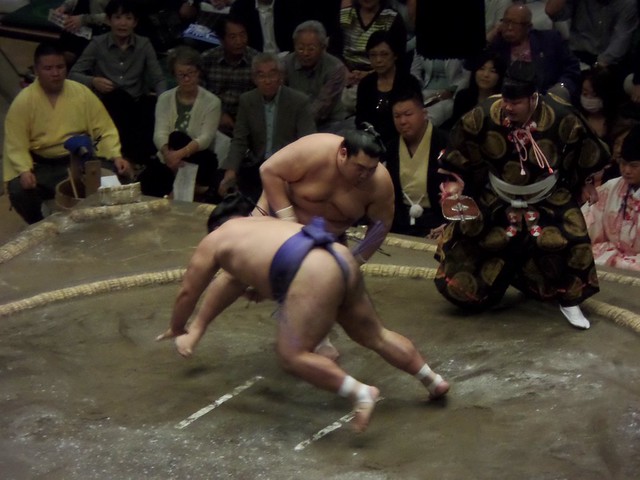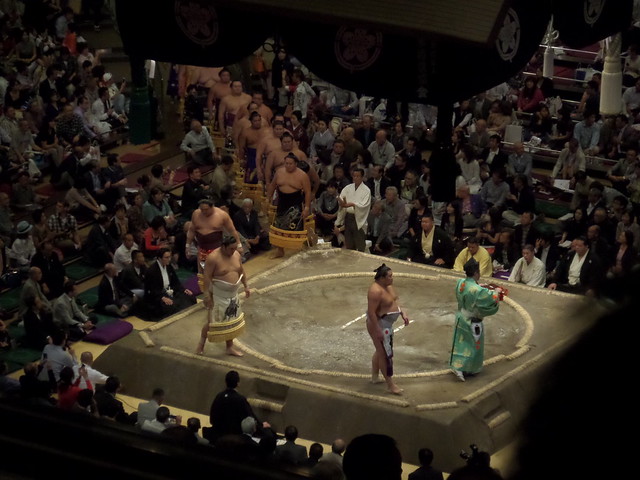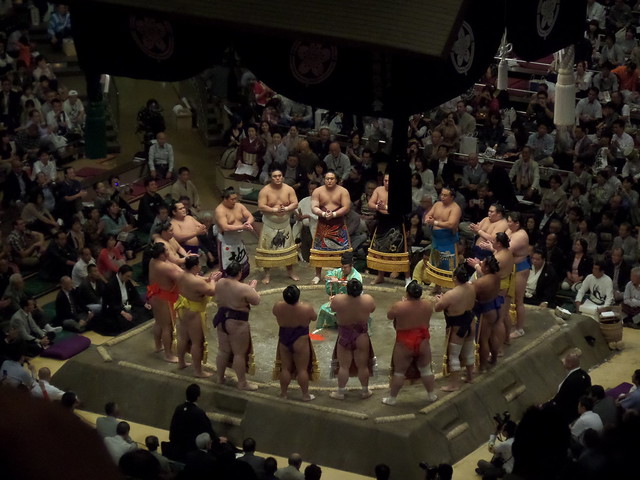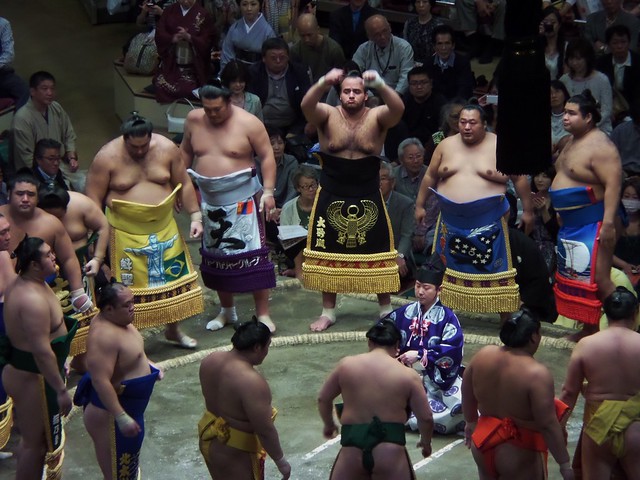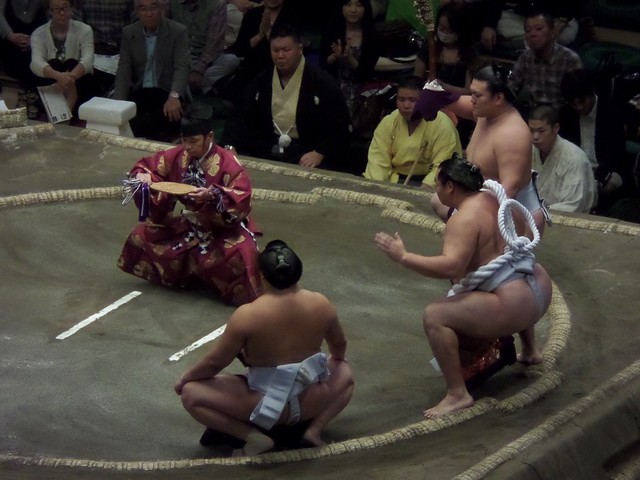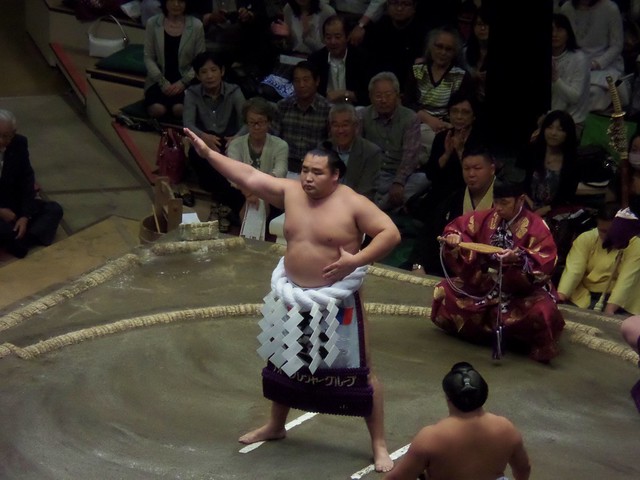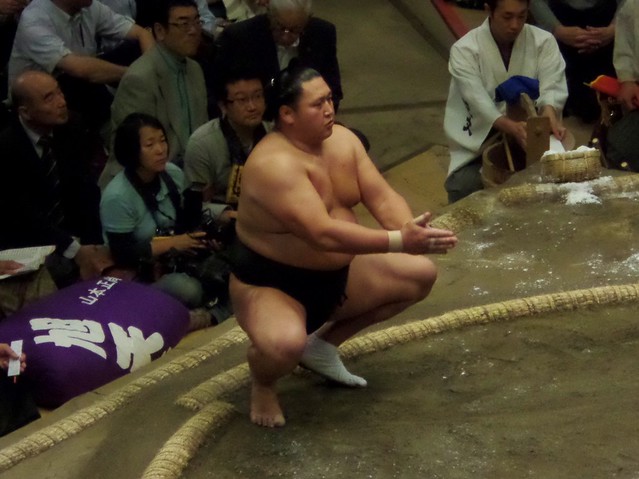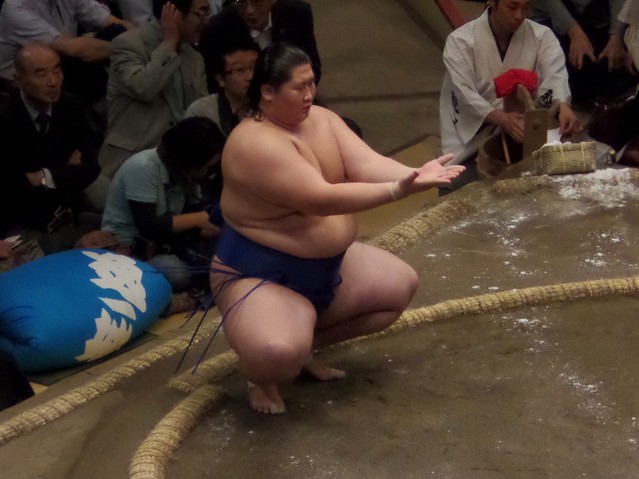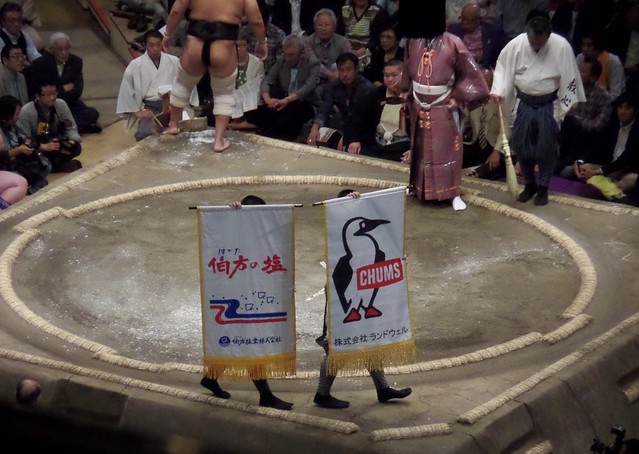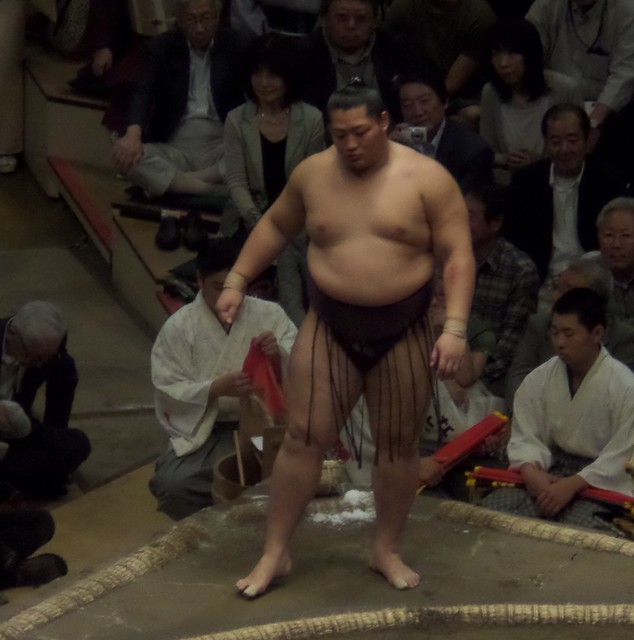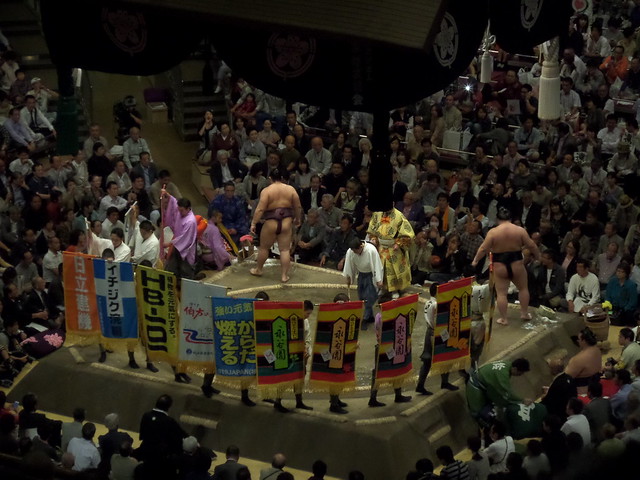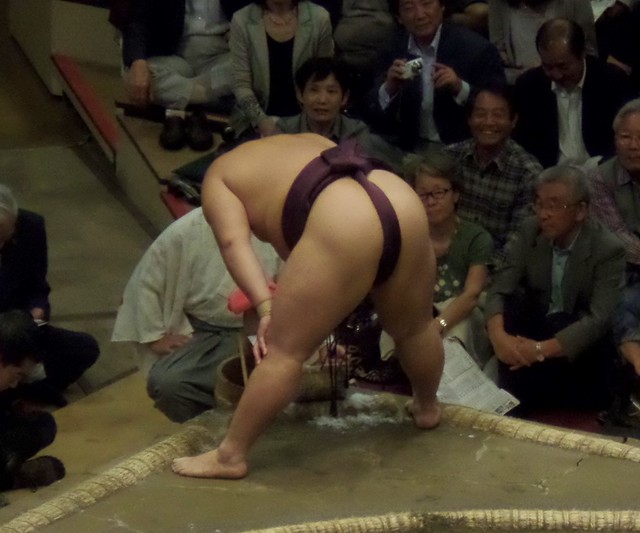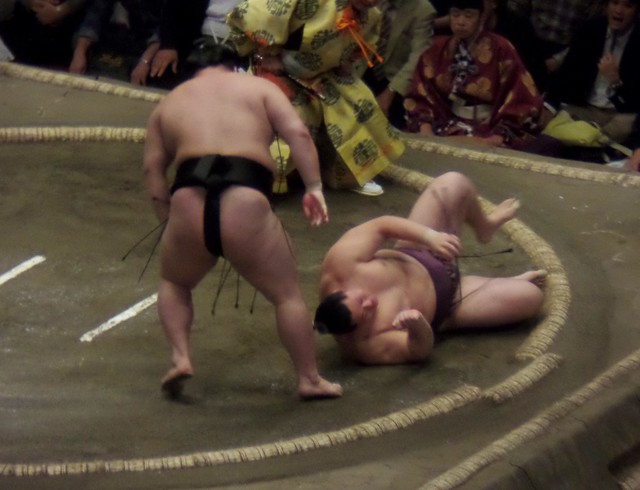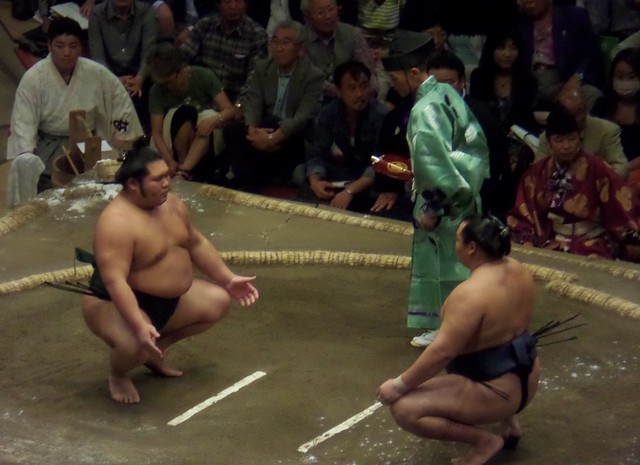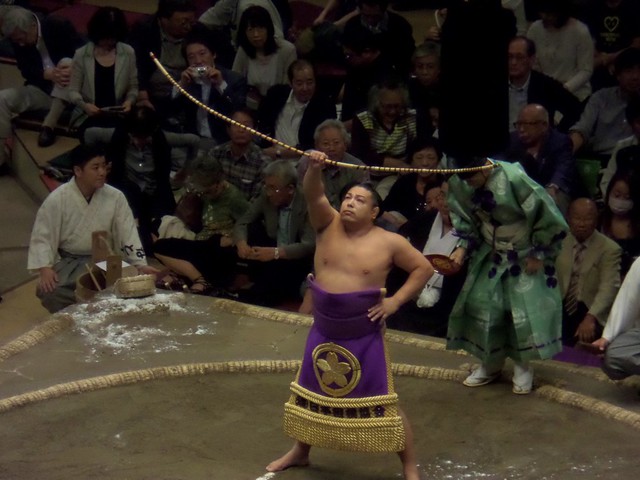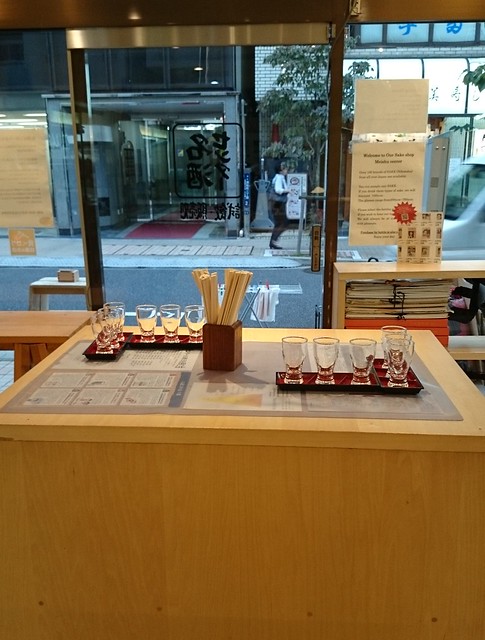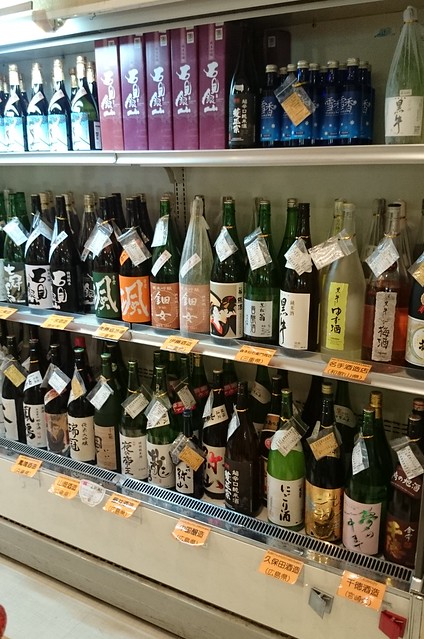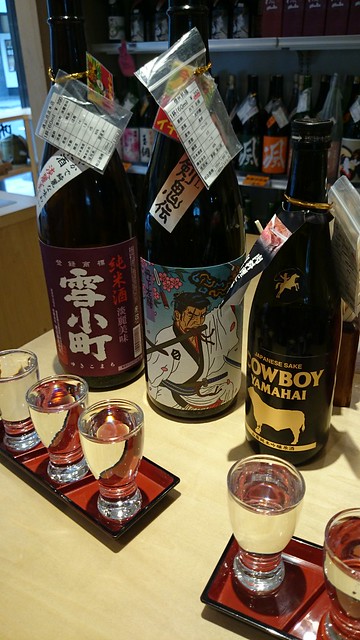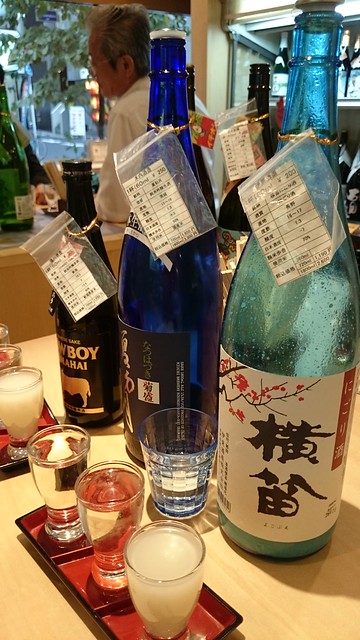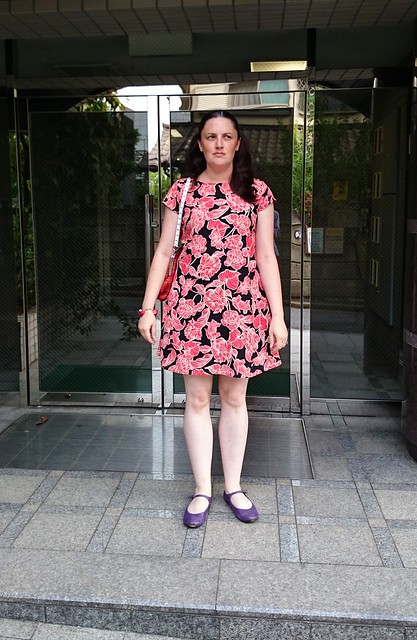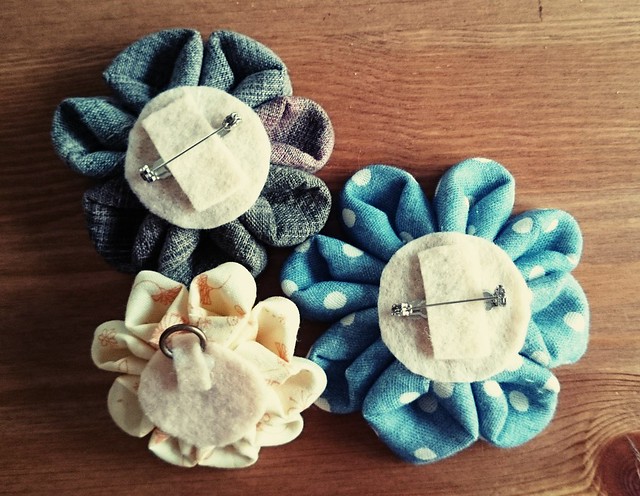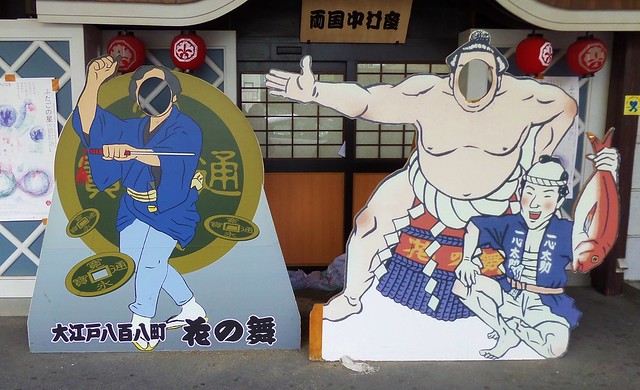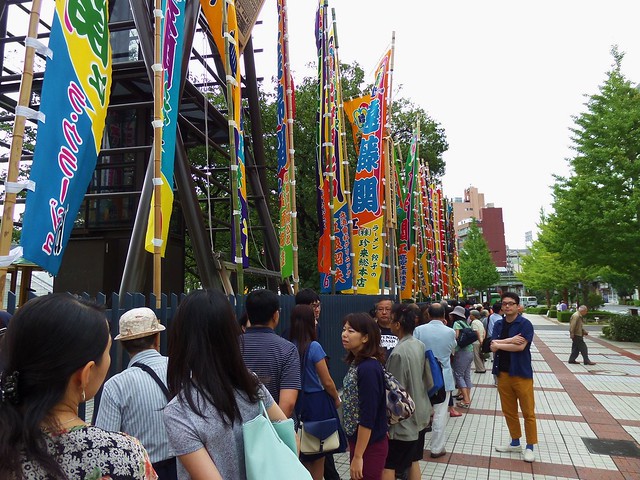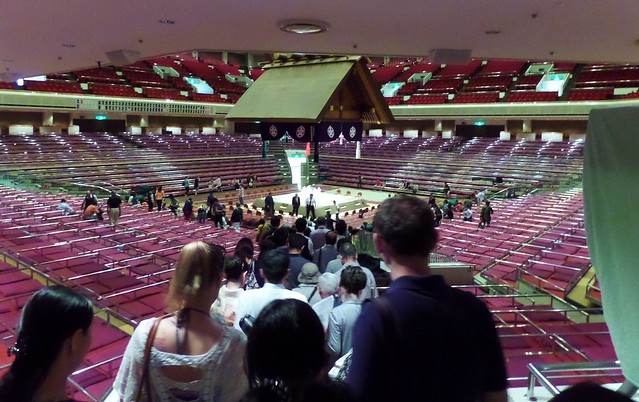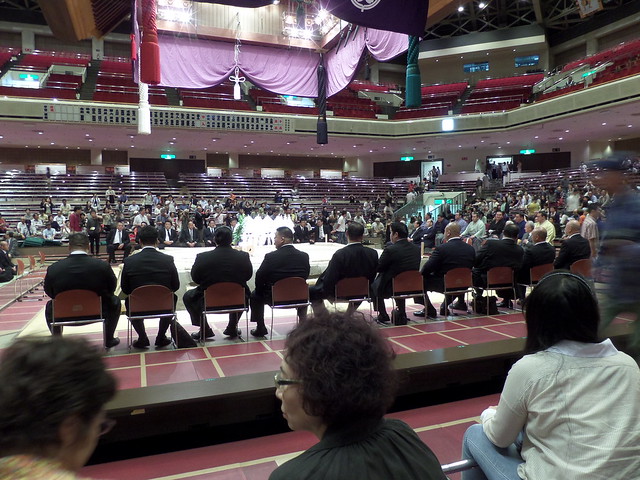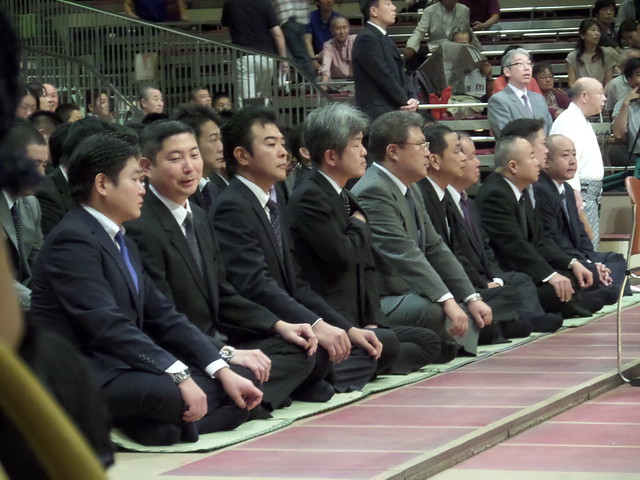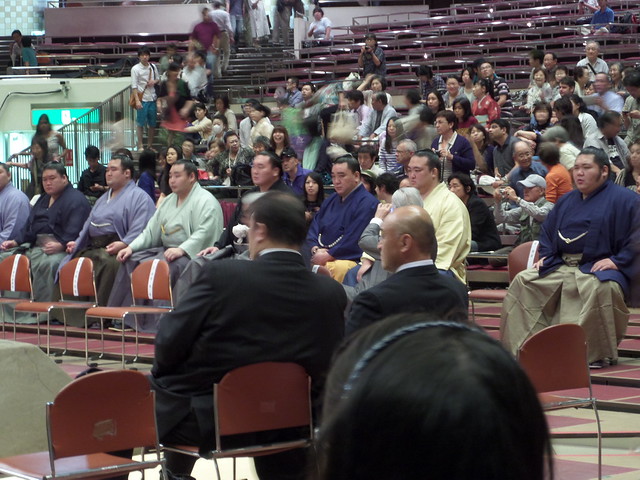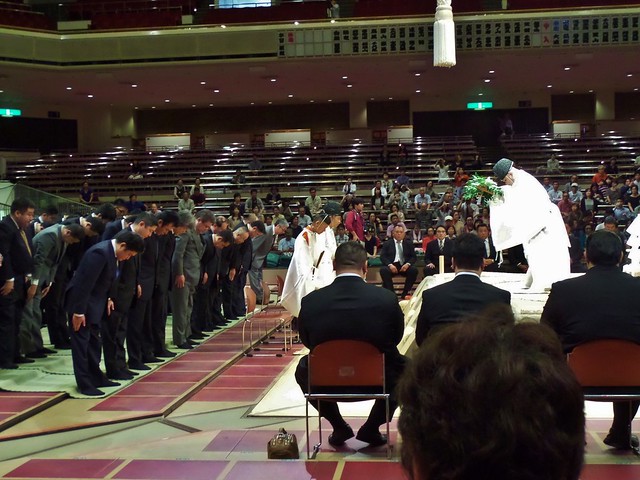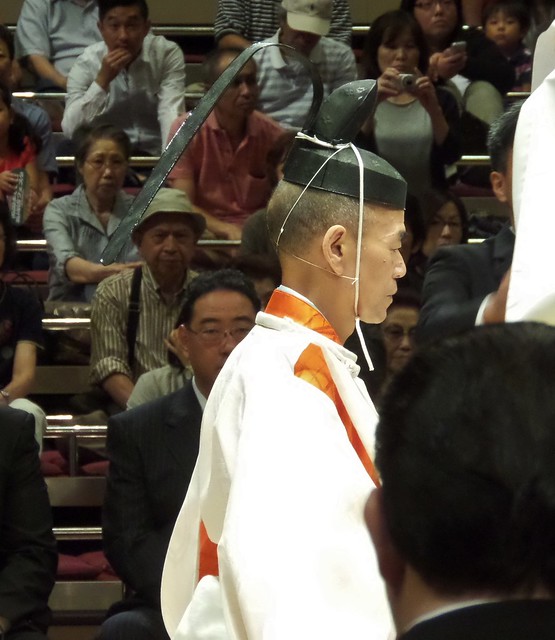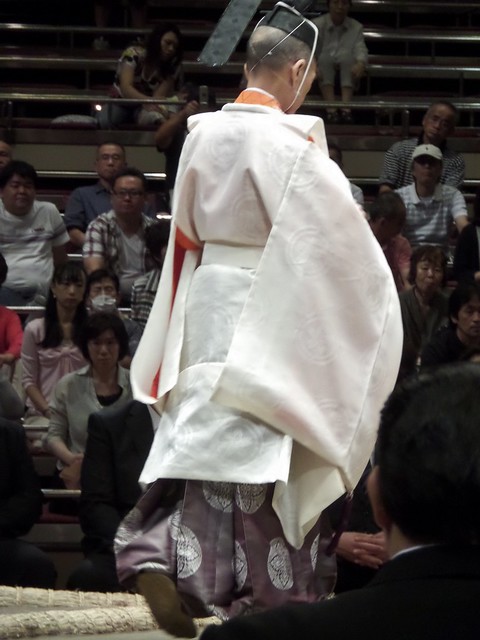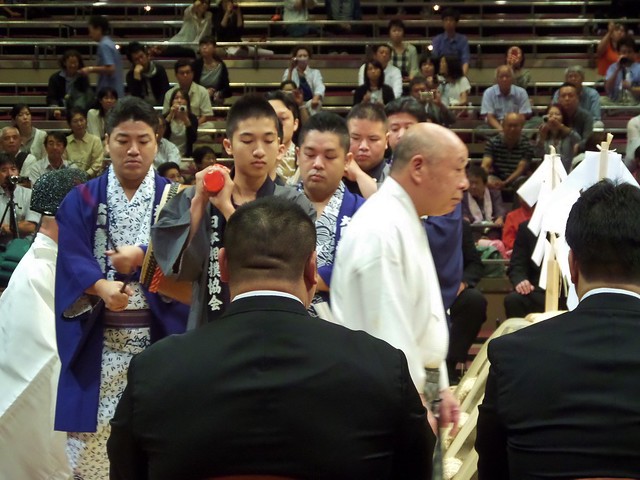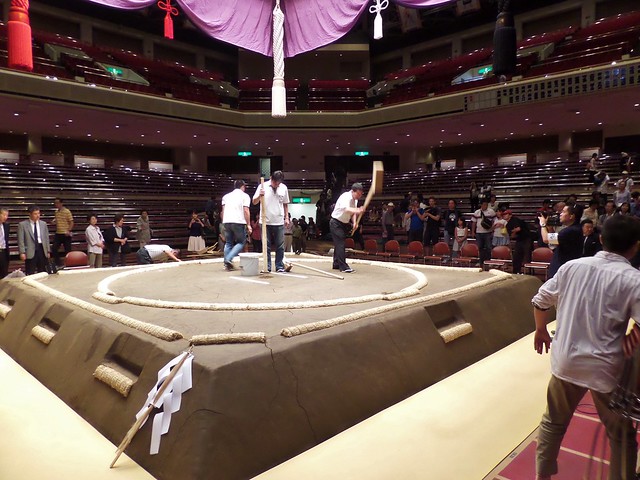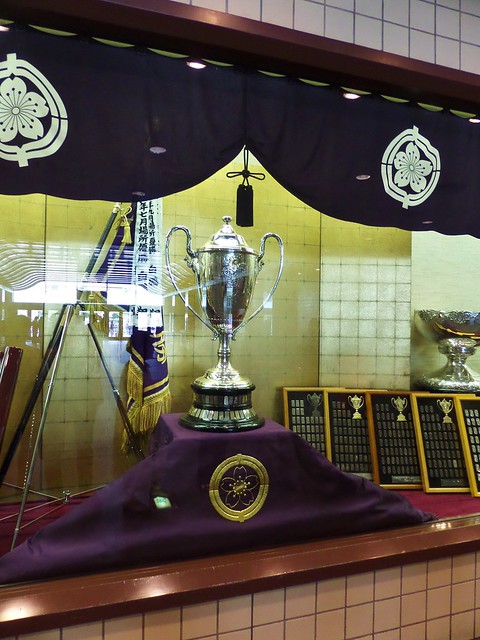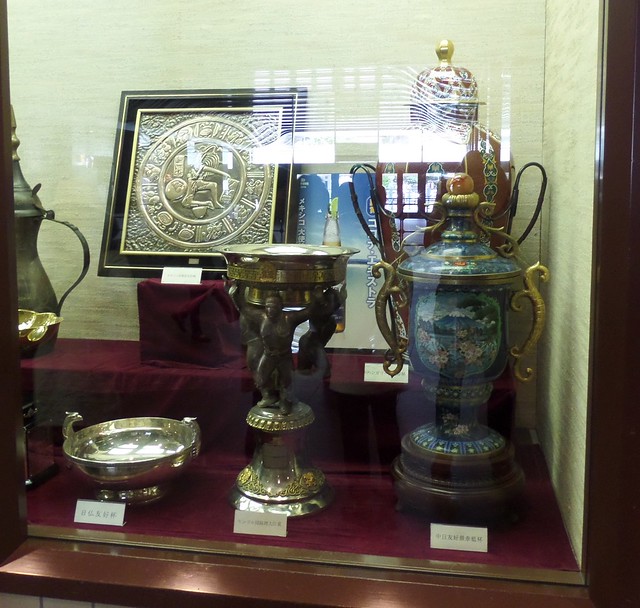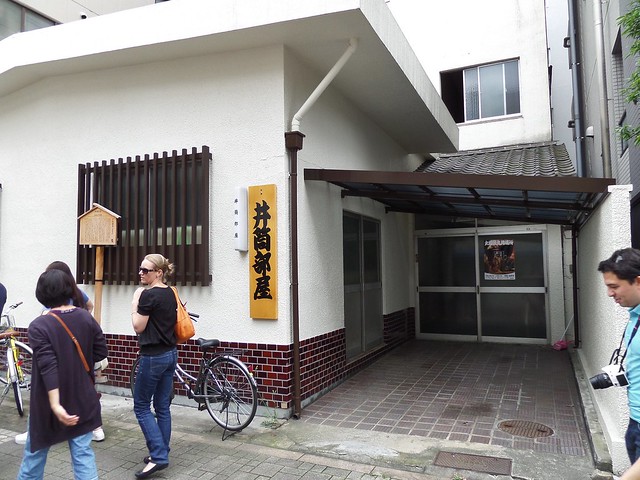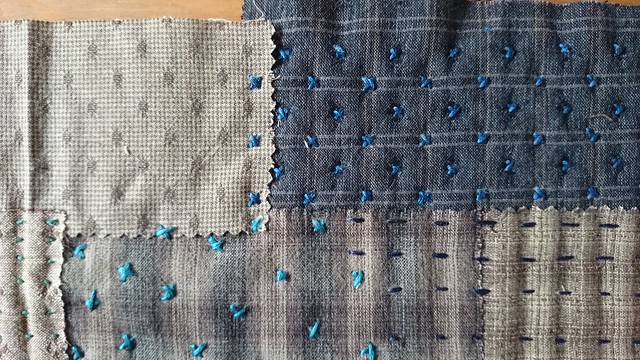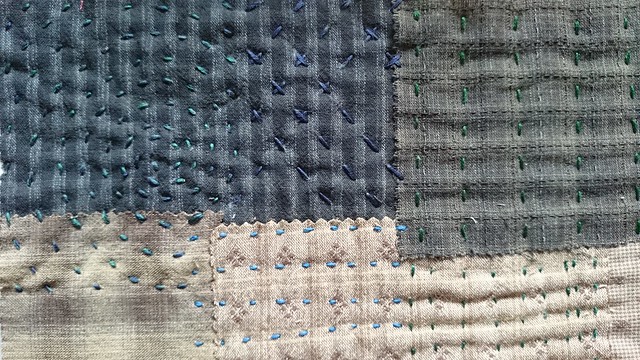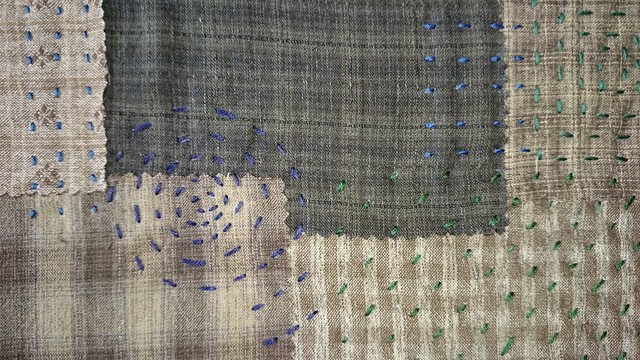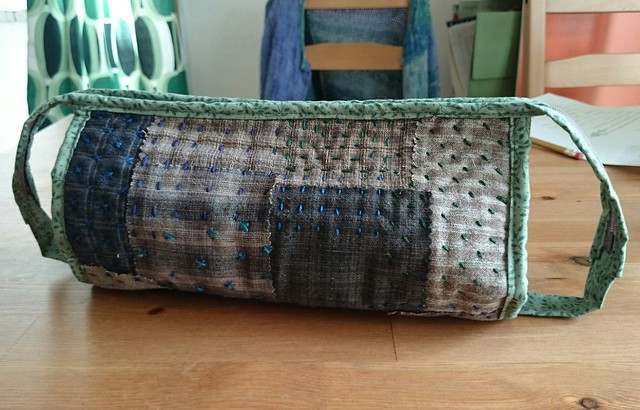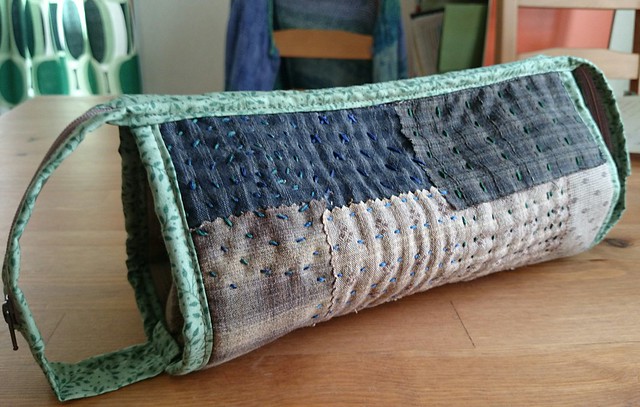Yesterday was my first experience of live Sumo. Needless to say, for a girl who loves WWE and Japanese culture, it was extremely enjoyable. The matches go from about 8.30am and start with the most junior wrestlers, working up through the ranks until the Juryo (second tier) at about 2.30pm and then Makuuchi (the cream) from about 3.40pm. Your ticket is for the whole day but it's quite normal for people not to arrive until 3ish. I got there about 12.30 and the place was fairly empty. See below - photos when I arrived and just before I left.
Yes, we were rather high up. Other photos were generally taken at the maximum zoom of my camera (x18) so that will explain the quality.
The early matches were the junior guys but they were still pretty big.
The guys in black around the edges are the five judges who decide who wins and adjudicate of there is any doubt. That very rarely happens, but excitingly actually did when we were there. You win a bout by making your opponent touch inside the ring with any part of his body other than his feet, or outside the ring with any part of his body.
The status of the wrestlers also dictates the kind of referee you get. The ref in the photo above has bare shins and feet and would not be allowed to preside over a senior level match. I found the robes the refs wore fascinating so made a little montage.
Those are all senior refs - indicated not just by robe length but also by their wearing socks and sometimes straw sandals, and also by the colour of their tassels and cords.
While things were quiet I had a good look at the crowd and saw some lovely groupings. Old geezers, who are in fact very rudely pointing the soles of their feet towards the ring - not the done thing.
Family group with a packed lunch.
I would have loved to have one of those 4-seat boxes on the ground floor but you have to buy all four seats and it comes to about £200. Our tickets up the top were still about £35 each, although for 8+ hours entertainment that doesn't work out too badly. Meanwhile outside there was major fandom going on as crowds of people waited for the senior wrestlers to arrive. I am not sure who this is but I happened to snap him as I was meandering around.
They each arrived with a little entourage of junior wrestlers who serve as their assistants/servants as part of their training. This guy was about two metres tall and highly impressive.
Once the junior matches have finished the Juryo wrestlers have their entrance which is very impressive. They parade in and surround the ring.
They are each wearing an embroidered silk apron, usually presented to them by a sponsor or fan. The guy in the front of the above photo, third from the left, is from Bulgaria and has the country's location map embroidered on his. The guys in this group were noticeably bigger than the first and showed a lot of skill, although that didn't always mean the matches were longer. This one can be described in three photos.
And that's back to the shower.
Then it was the turn of the very senior guys - the Makuuchi. They paraded in in the same way, led by the senior referee.
Once in they stood facing outwards, then turned inwards, clapped and raised their arms.
The guy with his arms still raised here is an Egyptian, and you can see the egyptian cartouche on his apron.
Two to the left from him is a Brazilian with the Jesus status on his. Once they had left it was time for the entrance of the Yokozuna. These are the Kings of Sumo. There can only be a maximum of four at a time and there are lot of requirements about how they must show their prowess before they get elected to this role. It is a huge honour to be made a Yokozuna and when a new one is named there is a big ceremony at one of the biggest shrines in Tokyo. They also get a larger than life size photo portrait of themselves hung in the main hall for all time - you can see some of these in the very first picture of this post. The three current ones are all Mongolian, which has caused a certain amount of consternation within Japan, and two were wrestling while we were there. Their entrances were paltry by WWE standards but what they lacked in 80s metal and fireworks they made up for in elegance and gravitas.
As well as the aprons, they wear these huge rope belts with elaborate looped fastenings which can weigh up to 35kg! They also have two attendants accompanying them. Once in they show their flexibility and strength by doing various maneuvers, the exact significance of which were lost on me.
The second Yokozuna to enter was Kakuryu, and one of his attendants was carrying a kendo sword.
A great to do was made about some matches which had sumo celebrities in them. This is Kyokutenho, who is my favourite having seen him wrestle on TV several times. His claim to fame is that he is 40 years old and there have only been six wrestlers older than him in the whole history of sumo. I've seen him interviewed and he has such a kind, happy face!
He contrasts with this newcomer (below) who is a mere 21 - he had come up through University wrestling where he had been champion and had not yet grown his hair long enough for the traditional top knot.
Popular matches can have sponsors, and their banners are carried around the ring after the wrestlers arrive but before the match starts. So for instance, this match had two sponsors.
This guy is also from the Uni circuit and is called Endo.
He is apparently THE sumo pin-up on account of his good looks (?) and so his match had a few extra sponsors.
A few? There were so many they had to do the flags in two batches. Each sponsor gives a cash prize to the winner in an envelope so for this match the stack of envelopes (which the ref hands over in a little ceremony at the end of the match) was about 4" high. This is Endo's bottom. Does it not make you want to lean forward and give it a little pat?
Reminds me of my niece. And then this is Endo's match.
Yep, he lost in about two seconds, making his result sheet this tournament show seven straight losses. Somehow I don't think he'll be sumo's darling for much longer. His opponent could easily have picked up £50k for winning this match alone on account of all those envelopes. The junior wrestlers get an annual stipend of a few thousand plus their food and lodgings but at the top end there is big money to be made from matches and most of all from endorsements and sponsors.
The only other matches to attract so many sponsors were those concerning the Yokozuna.
They each won their own matches, much to the delight of the crowd.
The final stage in the sumo day is the bow twirling ceremony. I think the judges choose someone who has performed well that day to do this but I am not 100% on that. In any case he was very impressive.
He was handed the bow by the senior referee and proceeded to twirl it all over in the most majestic cheerleader performance you'll ever see.
Leaving the stadium, the drums were being played from the top of a tall, free standing tower in the front of the stadium grounds, to let the neighbourhood know that events had finished for the day. The atmosphere outside was lovely - like a happy crowd after their team won at home. There were a number of elderly gents with their elderly friends who had obviously had rather too much beer and were heading back to the station like very gentle dodgem cars. Everyone was in high spirits and personally I would love to go back another day!
Sunday, 21 September 2014
Thursday, 18 September 2014
1200th Post - Sake Tasting in Daimon
I am not a big drinker, and before I came to Japan I had only had sake (pronounced sar-kay) hot. Over here there are Tabehoudai restaurants where you pay to go for, say, 90 minutes and during that time you can eat as many things on skewers as you want and also drink beer or sake to a reasonable extent along with it. Not drinking beer, the first time I went I opted for sake and it was served ice cold. Suddenly, I was liking sake a whole lot more. This discovery ultimately led to yesterday's outing to Nihon-shu, a sake tasting venue near Daimon station.
This is the kind of place we don't have in the uk. It was halfway between a bar and an off license, without being remotely like either. We went in and the staff were very nice with enough english to work it all out. You basically choose three bottles from the 100+ in there. Each one has a label in both japanese and english giving the price per glass and per bottle, the acidity, the sake meter reading (basically how sweet or dry it is) the type of sake, the prefecture it was made in and the percentage of polished rice used. You take the bottles back to your spot and the staff pour you a shot glass full of each one (full to the brim, not like an english measure) and you pay before getting down to the tasting.
There is absolutely no sales pitch - the staff just pour and go - which was rather nice as it leaves you to chat to whoever you're with. The others there were mostly salary men (office workers) in ones and twos. Most were men but there were a few women.
I generally drink the house sake (which there usually is on a restaurant menu along with the house red or white) and had no idea what the different numbers would translate into. So with a fairly random approach we chose three.
Going from right to left, the Cowboy one was actually divine and we ended up bringing a bottle back with us. The middle one was a lot sweeter which I imagined I would prefer (you know me and sweets) but actually I didn't at all. The final one I found quite bland. Now at this point your intrepid heroine was feeling a little bit light headed. Three glasses of 14-18% sake is as much as I would usually have in an evening and this had taken about quarter of an hour. I was longing for some french bread, or even a slice of mother's pride, but all we could find were rice crackers and some admittedly lovely smoked mackerel, but neither of these are that well known for their absorbant or stomach lining properties. I took a tight hold of myself, and the table, and got ready for round two.
Pooch picked the two blue ones while, after having a good look, I decided to stick with the Cowboy since I really did like it that much. As you can see from the glasses the pale blue one was unfiltered meaning it still had some of the rice's natural starch in it and some bits of rice husk, leaving it looking like watery yoghurt - not exactly attractive and the kind of thing where I needed to be already three sheets to the wind before I tried it. Fortunately I was, so I got stuck in. The consistency was a bit like a watered down fruit smoothie and the taste was actually very mellow, although not something I particularly loved. The middle one was a lot yellower in appearance than those of the first round but still the Cowboy stayed as my favourite.
At this point I was firmly clutching the table with one hand and trying not to drop my rice crackers as six glasses of sake is really not my average night. I was all too aware that I might not be looking as sensible as I had been when I set out.
Pooch, however, is Mancunian and made of sterner stuff. Plus he was wearing trousers so no one would see his pants if he fell over. He went in for round three, No photos exist of this third round, of which I have only vague memories, but we still came away with just the Cowboy bottle so I guess none of them grabbed him.
I thought this was a perfect place for an after work drink but not somewhere to plan to spend more than half an hour or so. If you were visiting japan it would be a great way to try some unusual sakes (most were 200-300 per glass so less than £2 but some were more than twice that) and find something you really like. It's a shame that the uk's drinking culture prohibits this kind of place from working there but here it works really well.
This is the kind of place we don't have in the uk. It was halfway between a bar and an off license, without being remotely like either. We went in and the staff were very nice with enough english to work it all out. You basically choose three bottles from the 100+ in there. Each one has a label in both japanese and english giving the price per glass and per bottle, the acidity, the sake meter reading (basically how sweet or dry it is) the type of sake, the prefecture it was made in and the percentage of polished rice used. You take the bottles back to your spot and the staff pour you a shot glass full of each one (full to the brim, not like an english measure) and you pay before getting down to the tasting.
There is absolutely no sales pitch - the staff just pour and go - which was rather nice as it leaves you to chat to whoever you're with. The others there were mostly salary men (office workers) in ones and twos. Most were men but there were a few women.
I generally drink the house sake (which there usually is on a restaurant menu along with the house red or white) and had no idea what the different numbers would translate into. So with a fairly random approach we chose three.
Going from right to left, the Cowboy one was actually divine and we ended up bringing a bottle back with us. The middle one was a lot sweeter which I imagined I would prefer (you know me and sweets) but actually I didn't at all. The final one I found quite bland. Now at this point your intrepid heroine was feeling a little bit light headed. Three glasses of 14-18% sake is as much as I would usually have in an evening and this had taken about quarter of an hour. I was longing for some french bread, or even a slice of mother's pride, but all we could find were rice crackers and some admittedly lovely smoked mackerel, but neither of these are that well known for their absorbant or stomach lining properties. I took a tight hold of myself, and the table, and got ready for round two.
Pooch picked the two blue ones while, after having a good look, I decided to stick with the Cowboy since I really did like it that much. As you can see from the glasses the pale blue one was unfiltered meaning it still had some of the rice's natural starch in it and some bits of rice husk, leaving it looking like watery yoghurt - not exactly attractive and the kind of thing where I needed to be already three sheets to the wind before I tried it. Fortunately I was, so I got stuck in. The consistency was a bit like a watered down fruit smoothie and the taste was actually very mellow, although not something I particularly loved. The middle one was a lot yellower in appearance than those of the first round but still the Cowboy stayed as my favourite.
At this point I was firmly clutching the table with one hand and trying not to drop my rice crackers as six glasses of sake is really not my average night. I was all too aware that I might not be looking as sensible as I had been when I set out.
Pooch, however, is Mancunian and made of sterner stuff. Plus he was wearing trousers so no one would see his pants if he fell over. He went in for round three, No photos exist of this third round, of which I have only vague memories, but we still came away with just the Cowboy bottle so I guess none of them grabbed him.
I thought this was a perfect place for an after work drink but not somewhere to plan to spend more than half an hour or so. If you were visiting japan it would be a great way to try some unusual sakes (most were 200-300 per glass so less than £2 but some were more than twice that) and find something you really like. It's a shame that the uk's drinking culture prohibits this kind of place from working there but here it works really well.
Wednesday, 17 September 2014
Teacher Byrne #2
My original bit of teaching for another organisation didn't work out as no one signed up. I have therefore branched out on my own and created a meetup group called "Tokyo Craft". So far I have listed a tour of the craft shops in Shinjuku, learn to knit, make a kanzashi flower and sashiko for beginners - and I have people signed up for each one! I thought I'd have a practise for the Kanzashi one and whipped up these.
The tweedy one is using traditional japanese fabrics while the other ones are patchwork off cuts. All have vintage button centres.
Two brooches and a pendant/charm. Those all use the same petal shape, and the one I think is the prettiest, but I've also been looking at the more delicate ones made differently using satin and silk. There are some beautiful examples and good tutorials on Pinterest. I've collected some here in case anyone wants them.
The tweedy one is using traditional japanese fabrics while the other ones are patchwork off cuts. All have vintage button centres.
Two brooches and a pendant/charm. Those all use the same petal shape, and the one I think is the prettiest, but I've also been looking at the more delicate ones made differently using satin and silk. There are some beautiful examples and good tutorials on Pinterest. I've collected some here in case anyone wants them.
2014 Dohyo Matsuri, Sumo Tournament Opening Ceremony
Last Saturday was the opening ceremony of the current Sumo tournament. There are 6 each year - 3 in Tokyo and 3 in other major Japanese cities. I missed the June one so as soon as the tickets went on sale for this month I was online. Pooch and I are going this weekend so this opening ceremony was a kind of warm up for me! The venue is next to Ryogoku station, which is therefore suitably decked out with the appropriate face cut out.
The venue itself is surrounded by these very brightly coloured flags, fluttering in the breeze.
Once we got inside it is a bit like any big stadium - lots of muddy coloured corridors with snack vendors dotted about and then double doors taking you into the main arena. Wow! It was pretty impressive.
The roof suspended over the ring resembles a Shinto shrine, emphasising the serious nature of the event. This isn't just fat guys grappling - this is a serious profession with many spiritual elements.
As the place filled up the ringside seats were taken by very serious looking men in dark suits. The presumably less important men (equality, never exactly advanced in japan, has not yet reached Sumo and absolutely everyone involved is male) were cross legged to one side, behind the Priests.
On the other side sat a row of Sumo wrestlers. I would have liked to know how they were chosen but can only speculate.
In all there are 47 training stables which contain roughly 640 wrestlers. The most junior have to get up at 5am and as well as training are servants to the senior ones. Wrestlers of any rank are only allowed to wear traditional japanese yukata and wooden shoes and have to obey a huge slew of rules. According to wikipedia, after one top guy was in a bad car accident they were forbidden from driving their own cars. That might be testicles but it could equally be quite true.
The three Priests processed in and sat down before the ceremony started. The Priest on the far side didn't have his own bit of ceremony to perform and just assisted the senior one.
The Priest nearest me was the first to get up and waved the bamboo branches to all four sides of the square and said some things before sitting down again. There was a lot of bowing going on. The two junior Priests wore very beautiful white silk outfits.
The bright spotlight over the ring meant they looked very angelic and almost seemed to be glowing. Their hats looked a bit like armadillo shells with black glitter on while the senior guy had an amazing hat - almost egyptian in appearance - which included a part that bent over the top of his head and boinged up and down as he moved.
He had a bit more colour to his outfit and some beautiful purple pantaloon type things on underneath.
I was itching to get a better look to see if they were woven, embroidered or printed! His part of the ceremony involved some lengthy chanting and overseeing the blessing of all four corners of the ring and the ring itself, assisted by the other two. Once the Priests had finished there were some big japanese Taiko drums carried around the ring twice by some younger guys.
And then just as suddenly as it had started it was over! All that remained was for the crew to fill in a post hole in the middle of the ring and use that huge wooden croquet mallet type thing to smooth and compact the surface.
Back outside there was a display of some of the trophies given to the winner. The main trophy is pretty impressive and stands about 3 feet high.
However, it isn't just the one trophy. Coca Cola gives a huge silver coke bottle. The Czech Republic gives a large crystal bowl. Lots of people give other bits and bobs. Everything in the case represents the trophies for just this tournament (I think - possibly for the year. It's difficult to be certain when all the labels are in japanese.)
It all adds up to a prize more like Supermarket Sweep than the FA Cup.
After a quick look around the onsite Museum (no photos allowed) we had a tour of some local Stables. These ranged from the quite impressive...
(Sneaky peak inside until the wrestlers saw a group of about 40 Gaijen peering in and closed the doors)
...to ones that looked more like a Scout Hut.
I have oodles of Sumo facts to share but I am going to save those for when I blog about the actual wrestling. I am really excited to be going!
The venue itself is surrounded by these very brightly coloured flags, fluttering in the breeze.
Once we got inside it is a bit like any big stadium - lots of muddy coloured corridors with snack vendors dotted about and then double doors taking you into the main arena. Wow! It was pretty impressive.
The roof suspended over the ring resembles a Shinto shrine, emphasising the serious nature of the event. This isn't just fat guys grappling - this is a serious profession with many spiritual elements.
As the place filled up the ringside seats were taken by very serious looking men in dark suits. The presumably less important men (equality, never exactly advanced in japan, has not yet reached Sumo and absolutely everyone involved is male) were cross legged to one side, behind the Priests.
On the other side sat a row of Sumo wrestlers. I would have liked to know how they were chosen but can only speculate.
In all there are 47 training stables which contain roughly 640 wrestlers. The most junior have to get up at 5am and as well as training are servants to the senior ones. Wrestlers of any rank are only allowed to wear traditional japanese yukata and wooden shoes and have to obey a huge slew of rules. According to wikipedia, after one top guy was in a bad car accident they were forbidden from driving their own cars. That might be testicles but it could equally be quite true.
The three Priests processed in and sat down before the ceremony started. The Priest on the far side didn't have his own bit of ceremony to perform and just assisted the senior one.
The Priest nearest me was the first to get up and waved the bamboo branches to all four sides of the square and said some things before sitting down again. There was a lot of bowing going on. The two junior Priests wore very beautiful white silk outfits.
The bright spotlight over the ring meant they looked very angelic and almost seemed to be glowing. Their hats looked a bit like armadillo shells with black glitter on while the senior guy had an amazing hat - almost egyptian in appearance - which included a part that bent over the top of his head and boinged up and down as he moved.
He had a bit more colour to his outfit and some beautiful purple pantaloon type things on underneath.
I was itching to get a better look to see if they were woven, embroidered or printed! His part of the ceremony involved some lengthy chanting and overseeing the blessing of all four corners of the ring and the ring itself, assisted by the other two. Once the Priests had finished there were some big japanese Taiko drums carried around the ring twice by some younger guys.
And then just as suddenly as it had started it was over! All that remained was for the crew to fill in a post hole in the middle of the ring and use that huge wooden croquet mallet type thing to smooth and compact the surface.
Back outside there was a display of some of the trophies given to the winner. The main trophy is pretty impressive and stands about 3 feet high.
However, it isn't just the one trophy. Coca Cola gives a huge silver coke bottle. The Czech Republic gives a large crystal bowl. Lots of people give other bits and bobs. Everything in the case represents the trophies for just this tournament (I think - possibly for the year. It's difficult to be certain when all the labels are in japanese.)
It all adds up to a prize more like Supermarket Sweep than the FA Cup.
After a quick look around the onsite Museum (no photos allowed) we had a tour of some local Stables. These ranged from the quite impressive...
(Sneaky peak inside until the wrestlers saw a group of about 40 Gaijen peering in and closed the doors)
...to ones that looked more like a Scout Hut.
I have oodles of Sumo facts to share but I am going to save those for when I blog about the actual wrestling. I am really excited to be going!
Friday, 12 September 2014
A Present of Sashiko
I mentioned in Thursday's post that I had made another 'Sew Beautiful' bag using some sashiko embroidery. Sashiko is the japanese word for 'little stabs', not to be confused with 'chiku chiku' which is the onomatopoeic phrase for sewing - chiku is said to be the noise the needle makes when it goes in and out of the fabric to form one stitch. The japanese are very keen on onomatopoeia. When I had finished the fabric I intended to use for the outside I had a strong urge to leave it as it was and frame it or something.
I really like how it turned out. I didn't use any traditional patterns so the embroidery is a bit random. I used scraps of traditional japanese fabrics and used the embroidery to secure them to a felt backing.
The finished object...
This will be making its way to england in time for my step-dad's birthday.
I really like how it turned out. I didn't use any traditional patterns so the embroidery is a bit random. I used scraps of traditional japanese fabrics and used the embroidery to secure them to a felt backing.
The finished object...
This will be making its way to england in time for my step-dad's birthday.
Subscribe to:
Comments (Atom)

